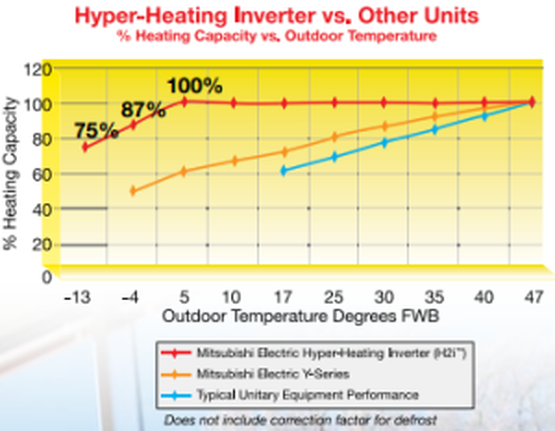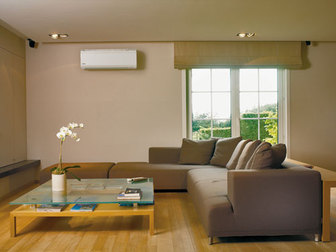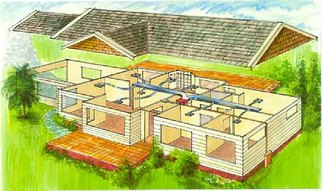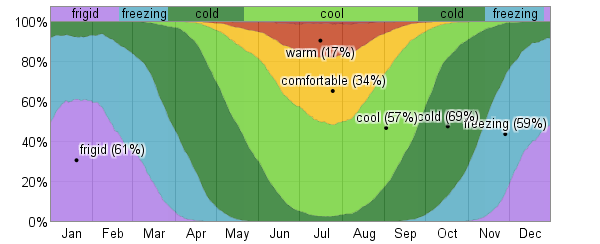This article is part of a free 10 page buyers guide to cold climate heat pumps. Download the full guide here.
This article will address many of the questions we get from homeowners about how heat pumps works, what a ductless heat pump is and some of the pros and cons of these units from a technical perspective.
There's been a lot of press about heat pumps in Maine lately, from the governor's love of the technology, to new legislation that will increase adoption of the technology, but there's still confusion about how they work.
Most of the information written about this technology is written by engineers and contractors for each other. While this information is amazing, we've found it's not written in a way that's useful to homeowners that want to utilize the technology to lower their heating bills.
This article was written for homeowners that are researching heat pumps as a way to provide very low cost heat to their homes.
By the end of this article, you will learn:
If you have any questions about the content please put it in the comments and we'll respond with an answer very quickly.
Let's get started.
What is a heat pump?
A heat pump uses electricity and a refrigerant to move heat between two places. Most often, this is between a the inside of a building to the outside of a building and vice versa. A heat pump does this by manipulating pressure and temperature of the refrigerant between two places. The most common forms of heat pumps in every day life are freezers, refrigerators, and air conditioning in your car or home. In all of these examples, heat is being removed from one place (the inside of your car or fridge) and put into another place.
While both air conditioning and heat pumps both use the same principles, the difference between air conditioning and a heat pump is just one thing, a heat pump can work in both directions. If your refrigerator could also heat the inside of itself, it would be a heat pump.
In the picture at the top of the article, a condenser is installed outside and an evaporator is installed inside. The condenser extracts heat from the outside air and transfers it to the inside of the room. It's important to note that in this picture, it's showing the heat pump in cooling mode. Cold climate heat pumps can also run in heating mode, where they're extracting heat from the outside of the building and putting it into the inside of the building.
What is a ductless heat pump?
A ductless heat pump, or a mini-split heat pump, is simply a heat pump that doesn't use any duct to distribute the conditioned air inside of the home. In a ductless system, the outside unit is connected to the inside unit only with refrigerant lines. These lines are connected through a 3 inch whole.
This contrasts with a ducted heat pump system that uses duct to distribute air around a conditioned space.
There are many benefits of a ductless heating system from a technical, economics, comfort, and aesthetic perspective.
This article will address many of the questions we get from homeowners about how heat pumps works, what a ductless heat pump is and some of the pros and cons of these units from a technical perspective.
There's been a lot of press about heat pumps in Maine lately, from the governor's love of the technology, to new legislation that will increase adoption of the technology, but there's still confusion about how they work.
Most of the information written about this technology is written by engineers and contractors for each other. While this information is amazing, we've found it's not written in a way that's useful to homeowners that want to utilize the technology to lower their heating bills.
This article was written for homeowners that are researching heat pumps as a way to provide very low cost heat to their homes.
By the end of this article, you will learn:
- What a heat pump is
- What a ductless heat pump is
- The pros and cons of a ductless heat pump
- How a heat pump moves heat between places
- What a cold climate heat pump is and how it's different than a normal heat pump
- Heat pump reviews. The manufactures that make the highest quality cold climate heat pumps
- How effective air source heat pumps are at heating in cold Maine winters
If you have any questions about the content please put it in the comments and we'll respond with an answer very quickly.
Let's get started.
What is a heat pump?
A heat pump uses electricity and a refrigerant to move heat between two places. Most often, this is between a the inside of a building to the outside of a building and vice versa. A heat pump does this by manipulating pressure and temperature of the refrigerant between two places. The most common forms of heat pumps in every day life are freezers, refrigerators, and air conditioning in your car or home. In all of these examples, heat is being removed from one place (the inside of your car or fridge) and put into another place.
While both air conditioning and heat pumps both use the same principles, the difference between air conditioning and a heat pump is just one thing, a heat pump can work in both directions. If your refrigerator could also heat the inside of itself, it would be a heat pump.
In the picture at the top of the article, a condenser is installed outside and an evaporator is installed inside. The condenser extracts heat from the outside air and transfers it to the inside of the room. It's important to note that in this picture, it's showing the heat pump in cooling mode. Cold climate heat pumps can also run in heating mode, where they're extracting heat from the outside of the building and putting it into the inside of the building.
What is a ductless heat pump?
A ductless heat pump, or a mini-split heat pump, is simply a heat pump that doesn't use any duct to distribute the conditioned air inside of the home. In a ductless system, the outside unit is connected to the inside unit only with refrigerant lines. These lines are connected through a 3 inch whole.
This contrasts with a ducted heat pump system that uses duct to distribute air around a conditioned space.
There are many benefits of a ductless heating system from a technical, economics, comfort, and aesthetic perspective.
- It can integrated with any existing heating system in any home. This is particularly amazing for Maine, which tends to have many types of old heating systems that would be impossible to integrate with for other types of heating system. This is because the set point of the heat pump is independent of other heating controls. This gives you the flexibility to set it to the temperature that you want on the unit itself.
- The installation is fast. This means less construction and and less time spent for homeowners dealing with installation crews. Also, because there is no complex duct work, it's a very simple installation with no evasive construction.
- High efficiency. Duct can be used to distribute heat to more places, but there's a lot energy loss in the fans it takes to move the air and within the duct itself. Eliminating the ducts means that more heat is delivered for a lower cost.
- More even heat in areas with a ductless system. Ductless systems perform better in distributing warm or cool air to a home, making living areas more comfortable. A single indoor unit can heat and cool a large living space, making these systems especially well suited to homes with open floor plans.
- Year round comfort. By installing a ductless system, you can enjoy year round comfort. Ductless systems come standard with air conditioning, offering you an energy efficient cooling solution.
Point Source Distribution vs Central Distribution
There is one downside to ductless heat pumps, but many don't even see it as a downside.
The inside unit can only distribute hot or cool air from a single place. This is called "point source distribution". Thus, it must be installed in a central location to maximize the ability of it to generate hot or cold air within the space. The central location should also be one of the most heavily used places in the home, so the heat pump can offset the largest portion of fossil fuel use that's possible and maximize comfort.
The reason that some people don't even see this as a downside is simple. In most cases, we don't need an entire home to be a "hot" to be comfortable because 80% of the time, we're only using a small section of the home. Older heating systems need to heat the entire home in order to warm the one place that you want to be warmer. A ductless system only heats the area that you want to heat, so you don't waste energy heating rooms that don't need to be heated.
You can see an example of a ducted heating system on the right. Below to the right, can you see a picture of a ductless system. A ductless systems needs to have the inside unit installed in a centrally located space so the air can be transferred to the largest portion of the home.
There is one downside to ductless heat pumps, but many don't even see it as a downside.
The inside unit can only distribute hot or cool air from a single place. This is called "point source distribution". Thus, it must be installed in a central location to maximize the ability of it to generate hot or cold air within the space. The central location should also be one of the most heavily used places in the home, so the heat pump can offset the largest portion of fossil fuel use that's possible and maximize comfort.
The reason that some people don't even see this as a downside is simple. In most cases, we don't need an entire home to be a "hot" to be comfortable because 80% of the time, we're only using a small section of the home. Older heating systems need to heat the entire home in order to warm the one place that you want to be warmer. A ductless system only heats the area that you want to heat, so you don't waste energy heating rooms that don't need to be heated.
You can see an example of a ducted heating system on the right. Below to the right, can you see a picture of a ductless system. A ductless systems needs to have the inside unit installed in a centrally located space so the air can be transferred to the largest portion of the home.
Installing the Cold Climate Heat Pump in a Central Location
To give you a specific example, below an example of a floor plan in a home. In most cases, we would want to install the heat pump in the family room, dining room or the living room.
This is a critical piece to understand and something you should discus with any contractor that you might work with to install a heat pump.
To give you a specific example, below an example of a floor plan in a home. In most cases, we would want to install the heat pump in the family room, dining room or the living room.
This is a critical piece to understand and something you should discus with any contractor that you might work with to install a heat pump.
How does an air source heat pump work?
This is a question that we get a lot. How do heat pumps work?
Let me try to explain the most complex part in the simplest way because I know that it can be hard to understand we can heat our homes with outside air during the winter.
This explanation is a very simple explanation of only half of the refrigeration cycle, but one that is the most confusing. This process outlines only how the heat pump is moving heat from outside of a home to the inside during heating mode. You can find more technical explanations of how the refrigeration cycle works in Part 1 The Magic of Air Conditioning and Part Two here.
What is a Cold Climate Heat Pump?
A cold climate heat pump are heat pumps that are able to heat effectively at lower outside temperatures, like the temperatures that we have in Maine.
Traditionally, heat pumps were used for cooling only and on the heating side they were only able to extract heat from the outside air down to 30F. This meant that most heat pumps were only used for very mild heating in regions like the mid-atlantic.
About a decade ago, massive amounts of research started to get commercialized around improved compressor technology. As compressors improved in strength while still being energy efficient, it became possible to extract heat from lower and lower outdoor air temperatures. Also, manufactures started to adopt larger heat exchangers on the outside condenser units to allow for more heat to be exchanged faster with the refrigerant.
You can see the difference in performance from normal heat pumps and cold climate heat pumps in the below graph from Mitsubishi. This graph shows the rated output of three types of heat pumps based on the outdoor temperature.
This is a question that we get a lot. How do heat pumps work?
Let me try to explain the most complex part in the simplest way because I know that it can be hard to understand we can heat our homes with outside air during the winter.
- Here's the fundamental thing you need to understand: There is heat in air that we perceive to be cold. Even though air at 5F seems very cold to us, the reality is that there is heat in this air and we can utilize this heat.
- Air at 5F still has enough energy to change the state of matter for some compounds from a liquid to a gas at lower temperature. We call this compounds refrigerants. In a heat pump, we push a refrigerant through an outside air exchanger that puts the 5F air in direct contact with the refrigerant. It evaporates the refrigerant, which then turns into a gas.
- There's a direct relationship between pressure and temperature. As temperature increases, all else equal, pressure increases. Similarly, if pressure increases in a system so too will temperature.
- Once the compound is in gas state, we increase the pressure to increase the temperature. Within the heat pump, the "compressor" is the piece of equipment that increases the pressure.
- The compressor runs on electricity. The compressor increases the pressure of the gas to increase it's temperature. This is the most important part of the heat pump in heating mode.
- The pressurized, and thus hot, gas is then moved inside of the home and distributed in the evaporator.
- Once a gas is 100F or higher, it becomes easy to move it across a heat exchanger to our homes that are at 60F and bring them to 70F.
This explanation is a very simple explanation of only half of the refrigeration cycle, but one that is the most confusing. This process outlines only how the heat pump is moving heat from outside of a home to the inside during heating mode. You can find more technical explanations of how the refrigeration cycle works in Part 1 The Magic of Air Conditioning and Part Two here.
What is a Cold Climate Heat Pump?
A cold climate heat pump are heat pumps that are able to heat effectively at lower outside temperatures, like the temperatures that we have in Maine.
Traditionally, heat pumps were used for cooling only and on the heating side they were only able to extract heat from the outside air down to 30F. This meant that most heat pumps were only used for very mild heating in regions like the mid-atlantic.
About a decade ago, massive amounts of research started to get commercialized around improved compressor technology. As compressors improved in strength while still being energy efficient, it became possible to extract heat from lower and lower outdoor air temperatures. Also, manufactures started to adopt larger heat exchangers on the outside condenser units to allow for more heat to be exchanged faster with the refrigerant.
You can see the difference in performance from normal heat pumps and cold climate heat pumps in the below graph from Mitsubishi. This graph shows the rated output of three types of heat pumps based on the outdoor temperature.
- The redline is a cold climate heat pump. You can see it maintains 100% output down to 5F outside and to -13F it still has 75% of it's output.
- The yellow and blue lines are examples of traditional heat pumps. This units heating capacity starts to decease at around 45F. By the time it's 20F outside, they've lost a substantial amount of heating capacity.
 Cold Climate Heat Pump vs Normal Heat Pump - Heating Output at Various Outdoor Air Temperatures
Cold Climate Heat Pump vs Normal Heat Pump - Heating Output at Various Outdoor Air Temperatures Cold Climate Heat Pump Manufactures and Reviews
I'll cover heat pump reviews in a latter article. For this article, it's important to understand that there are five major manufactures that are manufacturing high quality cold climate heat pumps. Those manufactures include:
- Fijitsu ductless heat pumps
- Mitsubishi heat pumps
- Sanyo heat pumps
- LG heat pumps
- Daikin heat pumps
Heat Pumps in Maine: How Effective are Cold Climate Heat Pumps in Cold Maine Winters?
Many people will ask, but can they handle cold Maine winters? Can they still be efficient when it's so cold out? Will they still save money in Maine? It's so cold here!
The reality is that if you look at the average temperatures in Maine, there's only a very small amount of time that the outside air temperature is regularly under 5F.
You can find information on the average temperatures in Caribou Maine here.
You can see in the below graph the average daily high and low temperature in Caribou, Maine. Caribou is one of the coldest places in Maine, so we can expect that most regions will be at least slightly warmer.
Average Daily Temperatures - Caribou Maine
Percentage of Time Spent in Various Temperature Bans in Caribou Maine
As you can see from above graph, even in January in Caribou, only about 60% of the time is spent below 15F.
For this reason, cold climate heat pumps can provide a substantial savings for Maine homeowners on their heating bills, even in our harsh winters. We'll talk about the economics of heat pumps in more depth in later articles.
For this reason, cold climate heat pumps can provide a substantial savings for Maine homeowners on their heating bills, even in our harsh winters. We'll talk about the economics of heat pumps in more depth in later articles.
10 Page Cold Climate Heat Pump Buyers Guide
This article is part of our free 10 page buyers guide on cold climate heat pumps.
You can click here to download the guide.
You can click here to download the guide.





